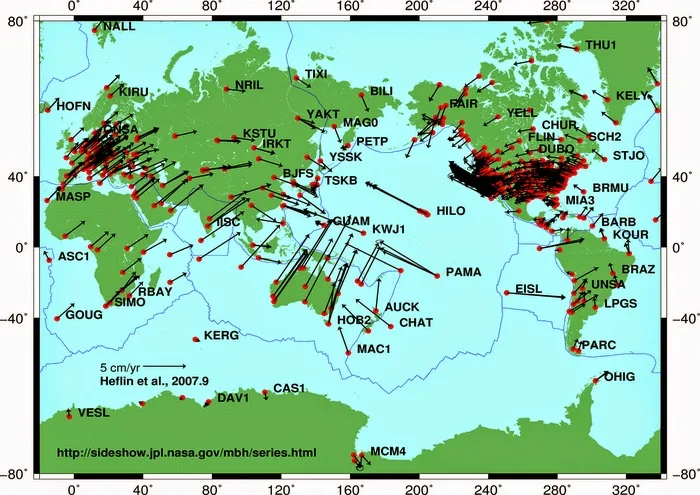Driving Forces of Plate Motion
 | |
|
It is generally accepted that tectonic plates are able to move because of the relative density of oceanic lithosphere and the relative weakness of the asthenosphere. Dissipation of heat from the mantle is acknowledged to be the original source of the energy required to drive plate tectonics through convection or large scale upwelling and doming.
The current view, though still a matter of some debate, asserts that as a consequence, a powerful source of plate motion is generated due to the excess density of the oceanic lithosphere sinking in subduction zones.
When the new crust forms at mid-ocean ridges, this oceanic lithosphere is initially less dense than the underlying asthenosphere, but it becomes denser with age as it conductively cools and thickens. The greater density of old lithosphere relative to the underlying asthenosphere allows it to sink into the deep mantle at subduction zones, providing most of the driving force for plate movement.
The same is true for the enormous Eurasian Plate. The sources of plate motion are a matter of intensive research and discussion among scientists. One of the main points is that the kinematic pattern of the movement itself should be separated clearly from the possible geodynamic mechanism that is invoked as the driving force of the observed movement, as some patterns may be explained by more than one mechanism.
In short, the driving forces advocated at the moment can be divided into three categories based on the relationship to the movement: mantle dynamics related, gravity related (mostly secondary forces), and Earth rotation related.
Driving forces related to mantle dynamics
For much of the last quarter century, the leading theory of the driving force behind tectonic plate motions envisaged large scale convection currents in the upper mantle which are transmitted through the asthenosphere.This theory was launched by Arthur Holmes and some forerunners in the 1930s and was immediately recognized as the solution for the acceptance of the theory as originally discussed in the papers of Alfred Wegener in the early years of the century. However, despite its acceptance, it was long debated in the scientific community because the leading ("fixist") theory still envisaged a static Earth without moving continents up until the major breakthroughs of the early sixties.
In the theory of plume tectonics developed during the 1990s, a modified concept of mantle convection currents is used. It asserts that super plumes rise from the deeper mantle and are the drivers or substitutes of the major convection cells. These ideas, which find their roots in the early 1930s with the so-called "fixistic" ideas of the European and Russian Earth Science Schools, find resonance in the modern theories which envisage hot spots/mantle plumes which remain fixed and are overridden by oceanic and continental lithosphere plates over time and leave their traces in the geological record (though these phenomena are not invoked as real driving mechanisms, but rather as modulators). Modern theories that continue building on the older mantle doming concepts and see plate movements as a secondary phenomena are beyond the scope of this page and are discussed elsewhere (for example on the plume tectonics page).
Driving forces related to gravity
Forces related to gravity are usually invoked as secondary phenomena within the framework of a more general driving mechanism such as the various forms of mantle dynamics described above.
Gravitational sliding away from a spreading ridge: According to many authors, plate motion is driven by the higher elevation of plates at ocean ridges. As oceanic lithosphere is formed at spreading ridges from hot mantle material, it gradually cools and thickens with age (and thus adds distance from the ridge). Cool oceanic lithosphere is significantly denser than the hot mantle material from which it is derived and so with increasing thickness it gradually subsides into the mantle to compensate the greater load. The result is a slight lateral incline with increased distance from the ridge axis.
Driving forces related to Earth rotation
Alfred Wegener, being a meteorologist, had proposed tidal forces and pole flight force as the main driving mechanisms behind continental drift; however, these forces were considered far too small to cause continental motion as the concept then was of continents plowing through oceanic crust. Therefore, Wegener later changed his position and asserted that convection currents are the main driving force of plate tectonics in the last edition of his book in 1929.


%20(1).webp)





